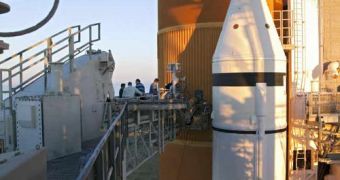In recent meetings aimed at monitoring the progress of repairs on the space shuttle Discovery, NASA officials have began adopting a more tempered tone when speaking about the spacecraft's chances of launching during the upcoming window of opportunity.
The orbiter was originally supposed to launch on November 1, but multiple delays have forced mission controllers to call it quits nearly 10 times since. After several weeks of delay, engineering crews said the shuttle may be launched on December 3, but other damages were also found.
At this time, Discovery is scheduled to take off no earlier than December 17, which is when the new launch window opens. If NASA cannot fly the STS-133 mission, then it will have to be postponed well into 2011, with the change reverberating through the rest of the flight manifest.
Fuel tank issues are currently the main problem facing the shuttle. NASA experts still don't know the factors that caused such large rips in the orbiter's massive external fuel tank.
As a result, “we'll leave the option open for a launch window for Dec. 17, but a lot of data has to come together to support that,” told the press in a November 24 briefing John Shannon, the manager of the shuttle program.
Tomorrow, December 2, officials at the American space agency will meet again, to discuss the current status of the spacecraft, as well as possible directions of action.
The new launch window remains open between December 17-20. NASA can scheduled up to three separate launch attempts within these four days, experts at the Kennedy Space Center (KSC) say.
Generally, the agency tends to avoid flying the shuttles during New Year, because the computers aboard the orbiter need to be reset when the year changes. NASA prefers its astronauts are not in space when this happens.
“They've never gone over the New Year's holiday. They've never done it before, and they prefer not to, but it's not something so terrible. It's not that the system would crash – the computers just have to be reset,” saID NASA spokesman Allard Beutel.
“In general, to shut down and reset the computers, they need to be safely on the ground, landed or docked to the station. in theory, they could do it while they're in flight, but that's never been done before,” he told Space in an email.
The issue with the new launch window is that it will create a hectic program on the International Space Station. If the orbiter launches on December 17, it will reach the lab on December 19, just two days after a Soyuz capsule takes up the three new members of Expedition 26.
If the STS-133 mission is moved to 2011, NASA will have the tough job of finding put when to launch Discovery. The ISS schedule is already full, as numerous activities are planned for next year.
“All windows are, to some degree, negotiable – it's just how much you can negotiate. But, that doesn't mean it's always going to be practical enough to be feasible,” the spokesman added.
“We have to work with the international partners and the station to change things around. There are a dozen and a half rockets and spacecraft heading to the station next year, so there's a lot of traffic,” he said.
“Then there are spacewalks and work going on at the station. All that stuff has to be factored in,” Beutel explained.
In the worst-case scenario, NASA says, Discovery could be launched next February, in the time slot initially alloted to shuttle Endeavor. The other orbiter's final flight could then be moved to April 2011.

 14 DAY TRIAL //
14 DAY TRIAL //